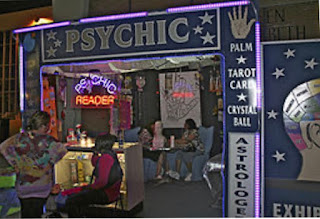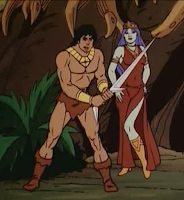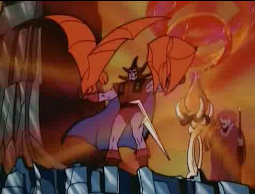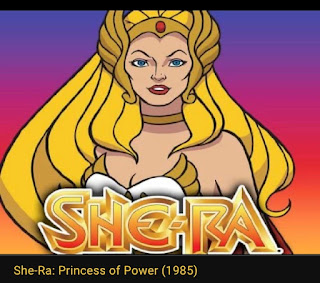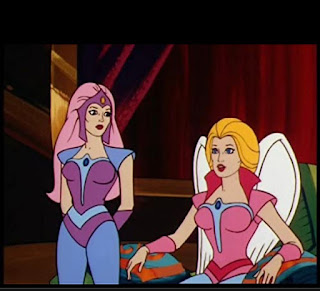Sunday, November 21, 2021
Don’t You Dare Go Gentle
Sunday, November 14, 2021
Supersonic Youth
One of the earliest forerunners to the programs discussed in this blog series, Space Sentinels was set in the then-futuristic 1985, nine years before Earth became irrevocably and catastrophically altered, if one is to trust the historical accounts of Filmation’s Thundarr the Barbarian, arriving a few years later in 1980. If that doesn’t confuse matters enough, 1985 also happened to see the cancellation of He-Man in addition to She-Ra’s debut!
Sunday, November 7, 2021
None But the Brave
Sunday, October 31, 2021
October Surprise!
 |
| A festive Jack-O-Lantern |
Strolling by the boardwalk vendors, my friends, Tim, Vinnie, Vinnie’s wife, Bonnie and myself were somehow prophetically drawn to a neon sign-GREATEST PSYCHIC IN WORLD-MADAME OUSPENSKAYA $10 PER PERSON. My cynicism was firmly in check but Tim and Bonnie thought it was an experience we had to share before leaving the following morning. So, reluctantly I went along with it and the four of us entered the small shop adorned with peeling wallpaper and ubiquitous incense.
 |
| Atlantic City |
 |
| JW's horse |
Sunday, October 24, 2021
Power Sword for the Overlord
Sunday, October 17, 2021
The Sun Sets on a Solid Site
I may even occasionally continue to post new reviews on the WMD weblog under my WMD Movie Reviews page, much like a prospector checks into an old ghost town now and again.
 |
| Click for the 'Western Magazine Digest' |
Sunday, October 10, 2021
Hoo-Ra for Girl Power!
On an Oz-like planet called Etheria, Princess Adora wields her ‘Sword of Protection’ to defend her people from a ruler named Hordak; a male villain, interestingly. She transforms as needed into the invincible She-Ra while leading a ‘Great Rebellion’ against evil forces known collectively as the ‘Evil Horde.’
So perhaps originality wasn’t She-Ra’s most prominent asset. The short-lived He-Man companion piece served its purpose nonetheless, filling a missing piece in the Filmation world’s puzzle while simultaneously proving that cartoons could balance out any inherent gender disparities with considerable style. In our own world we often dream of a day when pigs fly and talking rainbow-striped unicorns roam the land. For She-Ra and her princesses of power, that was just a typical walk in the park. Powerful, indeed.
Sunday, October 3, 2021
He Da Man!
Sunday, September 26, 2021
Bad Kids Aplenty
I believe it has a lot to do with children being just like us, yet being different enough to stand apart, especially when there is something "off" about them (like the blonde wigs they used on the dark-haired children of Village of the Damned). The same goes for elderly people. Give them subtle macabre makeup or make them move strangely, and they can be absolutely frightening (the old-lady scene from It Follows springs to mind here). And when we are menaced by those over whom we thought to have absolute control – those who are smaller, weaker, and intellectually less developed – then is there anything left besides feeling utterly powerless?
Is this one of the first reference books on this particular topic to ever be published?
I have found one academic book in English, focusing on only a handful of classics (The Bad Seed, Village of the Damned), and one in French, equally serious in tone and aimed at literature. However, Evil Seeds is the only reference book that covers nearly all of the evil-child movies ever made (nearly 250 feature films from 40 different countries, and even more minor evil-child appearances in other movies). I wanted to create a book that not only gives readers insight into the stories they love, but also gives them plenty of new ones to discover.
How is Evil Seeds different from your previous reference guides?
When Animals Attack and Strange Blood very much started with the contributors and their unique vision on, and experience with the film. They were odes of love to particular films within the subgenres of animal-attack movies and offbeat vampire movies. Evil Seeds, on the other hand, is encyclopedic in nature as it covers nearly all the titles that exist within this particular subgenre.
 |
| Vanessa Morgan, author |
I'm completely in love with The Children of Ravensback (1980). I realize it's not the most intelligent or classy evil-kid movie out there – on the contrary – but it contains all of the elements that make a movie like this fun: creepy children, lots of murder scenes, subtle humor, and a great atmosphere. At the beginning of September, I screened and introduced this film at the BUT Film Festival in Breda, the Netherlands, to people who had never even heard of The Children before, and they were all in stitches. And what a delight to see my favorite on the big screen.
Do
you have a particular recollection of seeing any of these films for
the first time? How did it affect you as a young writer?
The
first evil children that come to mind that scared me were the Grady
twins from The Shining and the brothers from Salem's Lot.
I watched Children of the Corn countless times on television
when I was in my teens, but I don't think it holds up that well. I
remember showing Bloody Birthday to my younger siblings, who
weren't into horror at all but thought the film was amazing
(especially the nudity) and wanted to watch it over and over again. I
was also lucky enough to see The Good Son (1993) in cinemas as
well. All these films started a passion that resulted in this book.
Do you find that there are characteristics of this sub genre that are unique to the different countries that produced them?
I love this question because I think this is the more interesting aspect of a book like this one. As with other film genres, these tropes often mirror the culture in which they are produced. In India, horror movies about evil children often involve the fear of black magic, whereas Ireland loves tackling fairytales about elves and changelings. In the Philippines, the evil baby Tiyanak is part of the cultural heritage. As the country grew its religious belief systems, the Tiyanak's characteristics evolved accordingly. Once the Spanish colonized the Philippines, the inhabitants were Christianized. The population copied the Christian values that abortion and non-baptizing are sins, so the myth transformed into Tiyanaks being souls of babies who died before baptism and later evolved into vengeful spirits from aborted fetuses.
On the other hand, the appeal of movies such as The Exorcist and The Omen was so huge internationally, that their cinematic influence was felt in countries where Christianity and the Devil weren't part of the main religious belief system (such as Egypt, India, Turkey, Japan, or Hong Kong), and this resulted in unofficial remakes and copycats.
What can your readers expect from you next?
I have MANY ideas for upcoming movie reference guides, and I probably won't wait too long to start a new one because I love the process of creating a book like this and introducing readers to obscure movies. But I have other projects I need to finish first – organizing the Offscreen Film Festival in Brussels, renovating my new apartment, writing the screenplay and short story that I already said yes to, and in between all that, promoting this book and cuddling my cat Romero.











